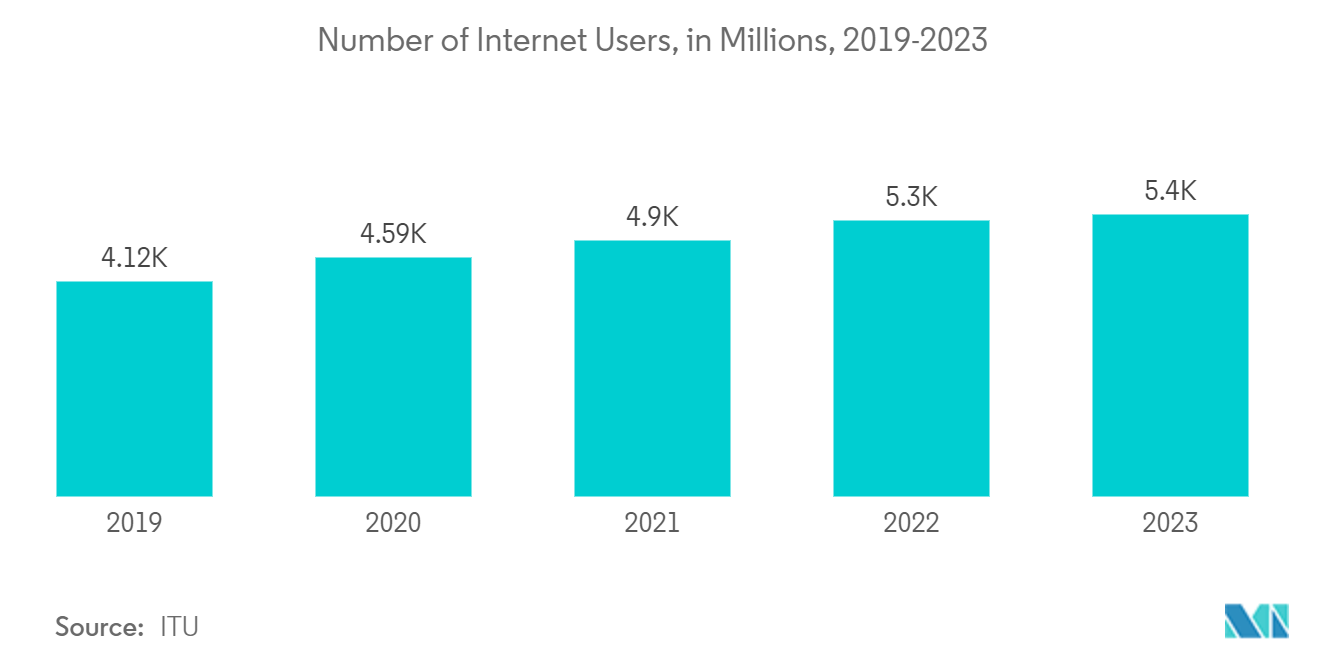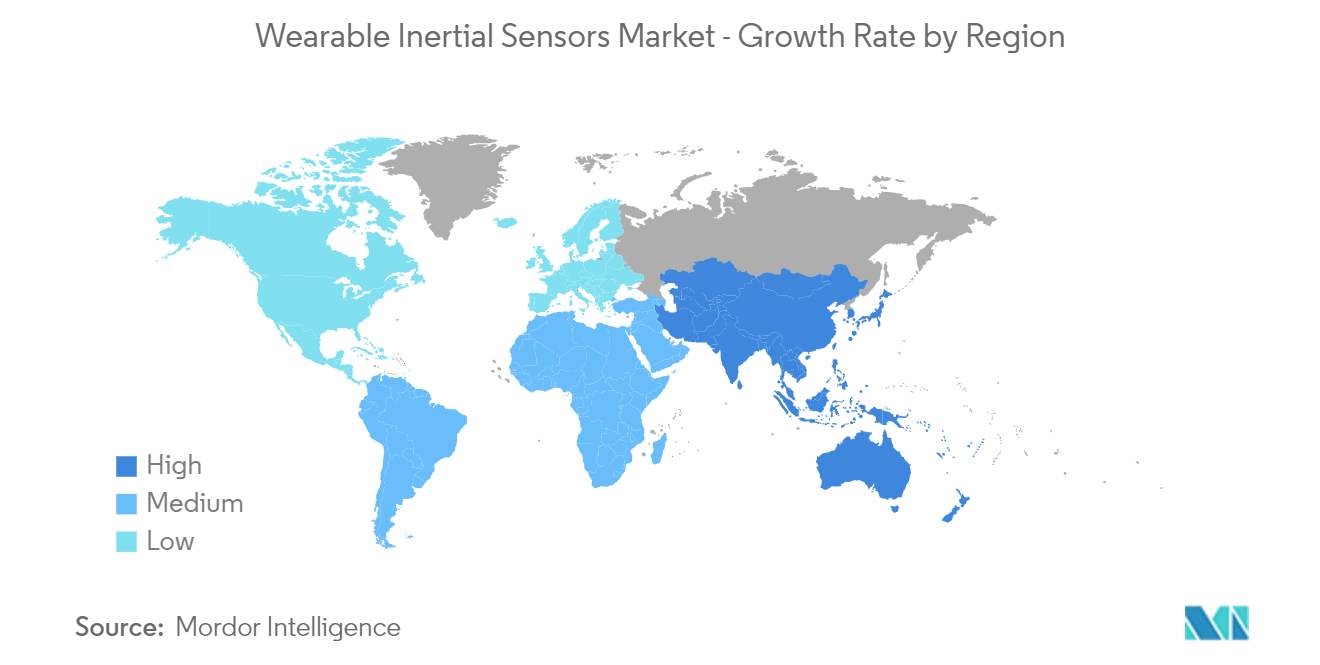Market Trends of Wearable Inertial Sensors Industry
Consumer Electronics to Witness Significant Growth
- Inertial wearable sensors technology, an emerging trend, integrates consumer electronics into daily activities and addresses the changing lifestyles with the ability to be worn on any part of the body. The trend of wearable inertial sensors in the consumer electronics industry is driven by the factors such as internet connectivity As per ITU, the approximate global internet user count reached 5.4 billion in 2023. and enhanced data exchange capabilities, enabling seamless communication between devices and networks.
- The growing advancement and reduction in the size of sensors, especially pressure sensors and activators, also exp anded the scope of the wearables inertial sensor market in the consumer electronics industry. As sensors become increasingly bio-compatible, their use for healthcare and fitness activities has also significantly increased. This has led to a significant increase in wearable devices sold over the past few years. According to Cisco, the growth in connected wearable devices, from 835 million devices in 2020 to 1.105 billion in 2022, holds great promise, specifically for healthcare applications. Many compa nies are investing in developing advanced Microelectromechanical systems (MEMS) and digital sensors, further decreasing their sizes and covering a wide range of market applications.
- The micro-electro-mechanical sensors (MEMS) and accelerometers are used for electronic stability control and airbag deployment. Inertial Measurement Units or IMU (they are a combination of MEMS Accelerometer and MEMS Gyroscope) have been developed for wearables as technology has advanced and are influenced by the impact of consumer electronic devices being used daily, such as global positioning system (GPS) or inertial measuring unit (composed of accelerometer, gyroscope, and magnetometer) sensors. This has helped fitness-tracking wearables revolve around these sensors exclusively.
- For instance, Nintendo Switch Labo edition Joy-cons possess default sensors in the accelerometer and gyroscope, usually in electronics consumer wearables. Joy-cons and cardboard combine to build artificial wearables, such as robots, to apply to a gaming function. It is usually Nintendo's way of breaking barriers for future generations (who are more involved with technology at younger ages) in immersive experiences with simplified custom wearable tech.
- Accelerometers are motion sensors, used in wearables. Their brand of acceleration, such as gravity and linear, demonstrates their sensing capabilities. Meanwhile, their measuring ability enables the programming of measured data for different purposes. For instance, a user who runs can access their top speed output and acceleration. Further, accelerometers can track sleep patterns like smartwatches and wristbands, thus driving the demand for wearable motion sensors in the consumer electronics segment.

Asia Pacific to Dominate the Market
- The Asia Pacific region is expected to witness notable growth during the forecast period owing to a large consumer base with a growing penetration of wearable devices and digital technologies. Considering the prospects, OEMs are also creating considerable support toward the enlargement of IMUs (inertial measurement units) and MEMS technology further to enhance the penetration of the newly developed products. Furthermore, the evolution of the electronics industry, owing to the emergence of countries such as China, Taiwan, etc., also contributes to the growth of the studied market.
- The market for wearable inertial sensors has become one of the largest and fastest-growing in China. Smartwatches, fitness trackers, virtual reality (VR) headsets, and motion-capture suits all use wearable inertial sensors, which are sensors that can detect motion and direction. The rapid growth of the wearable inertial sensor market in China has been primarily fueled by the country's rising acceptance of wearable technology and its expanding population of health-conscious individuals.
- The growing popularity of wearable technology and rising demand for measuring one's health and fitness have both contributed to the enormous rise of the wearable inertial sensors market in India in recent years. Wearable inertial sensors, such as accelerometers, gyroscopes, and magnetometers, are essential for giving wearable devices information about motion and orientation, which makes them popular for customers, athletes, and healthcare professionals in the nation.
- Japan's technologically proficient environment and a society that values convenience and innovation has propelled consistent growth in the wearable inertial sensor market there. Wearable inertial sensors have several uses in the healthcare, sports, entertainment, and gaming industries, among other fields. The use of wearables with inertial sensors for monitoring and enhancing general well-being has been accelerated by Japan's aging population and a strong focus on health and wellbeing.
- Due to the nation's tech-savvy population and keen interest in wearable technology, the South Korean Wearable Inertial Sensors Market has rapidly expanded in recent years. Smartwatches, fitness bands, virtual reality headsets, and other wearable medical equipment all feature wearable inertial sensors to some extent. Due to the rising emphasis on entertainment, health, and fitness and the adoption of advanced technologies, the demand for these gadgets has increased in the South Korean market.
- The Rest of Asia Pacific's inertial sensor market, which includes nations like Singapore, Australia, Malaysia, and others perceiving demand for wearable sensors in the Rest of Asia Pacific, has been steadily increasing over the past few years, driven by a growing interest in fitness and wellness, a rising aging population, as well as advancements in technology and healthcare.


